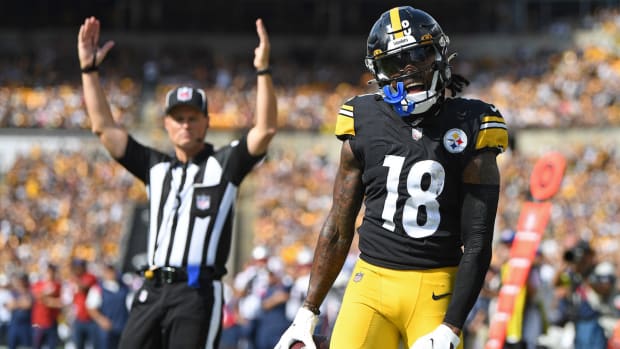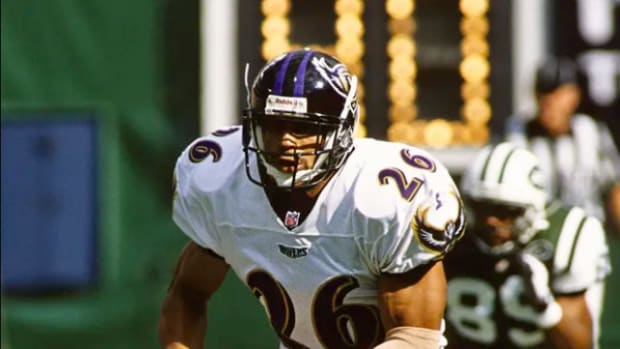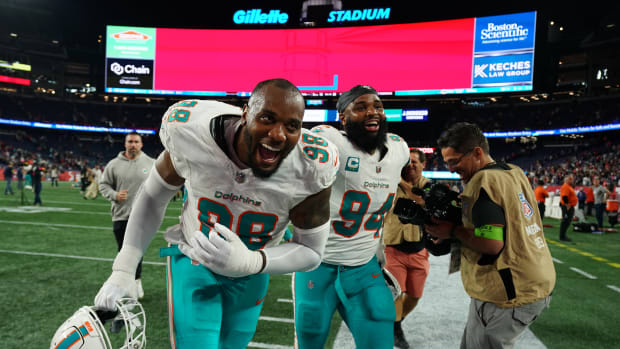How the Bears Are Building Trubisky for a Super Bowl Run
With about seven minutes remaining in regulation and the visiting Lions finally showing some semblance of life after scoring back-to-back touchdowns, Bears first-year head coach Matt Nagy had to figure out how to protect his team’s 34-22 lead. Instead of just pounding the rock and relying on tailback Jordan Howard’s tackle-breaking prowess against a talented but maddeningly inconsistent Lions run defense, Nagy did the same thing he did in a similar situation against the Jets two weeks earlier: He kept running his offense. Yes, that meant keeping the ball on the ground at times, but it also meant keeping the game in Mitchell Trubisky’s hands, calling upon the second-year QB to drop back and throw. Nagy didn’t have to; the Lions were out of timeouts. He could have taken the double-digit lead, handed it off safely to drain a few minutes and then put his terrific defense back out there.
Like in the Jets game, Trubisky responded well. On a second-and-12 he hit receiver Allen Robinson for eight yards, then scrambled for another eight to convert the third-and-4. A few snaps later, Trubisky converted a third-and-5 with a 15-yarder to wideout Anthony Miller, allowing the Bears to ice the game.
The Bears are now 6-3. Nagy’s semi-aggressive mid-fourth quarter approach is representative of what it will take for them to make a deep playoff run. A deep run might sound crazy to Bears fans, who haven’t witnessed mid-January football since 2010, but it’s entirely possible. Or, it’s possible if Trubisky continues his upward trajectory.
That’s a big if, and it’s important to note that that trajectory is only a gradual slope. But that’s all the Bears, one of football’s most complete teams, need from their young QB. Trubisky is being asked to manage a well-designed offense. Much has been made about Nagy’s scheme being the NFC version of Chiefs coach Andy Reid’s. Indeed, the Bears feature a lot of pre-snap motion, misdirection and multi-option designs. But the difference is, while Reid uses the scheme as a weapon to feature his young QB, Nagy uses the scheme as a tool to hide his. The Bears are Chiefs Lite.
This is why Trubisky’s upward trend is so critical. Few offenses can go very far running the Lite version of their scheme. Nagy knows this, and he’s taking smart measures to address it. Against Detroit, he drifted away from the heavy dosage of condensed formations that, for Chicago, have propagated a dink-and-dunk system. He increased his usage of open formations and downfield route concepts. Schematically, it looked like a big leap forward, but Nagy wisely gave his quarterback a crucial stepping stone: many of the open formations featured three receivers to one side and tight end Trey Burton by himself on the other. This told Trubisky the coverage pre-snap—if safety Tavon Wilson was across from Burton it meant the Lions were in man-to-man, if cornerback DeShawn Shead was across from Burton it was zone. (Incidentally, Shead was only in because Lions top corner Darius Slay was out with a knee injury. The Bears really took advantage of that downgrade in the first half.)
Knowing the coverage, Trubisky was clear on where to begin his reads. He’s a different player when the action is defined early in the snap like this. Trubisky’s arm and athleticism are not great, but they’re certainly enough for him to build a quality career. For that to happen, Trubisky must develop into a timing-and-rhythm thrower first, with his sandlot playmaking abilities coming second. The order of those is crucial. When Trubisky struggles, it’s almost always because he’s relying on his ability to scramble and throw on the move. That leads to inherent highs and lows.
If you want the latest episode of The Monday Morning NFL Podcast in your feed when you wake up Monday morning, subscribe to The MMQB Podcasts. (For non-subscribers, there is typically a lag.)
Think of Trubisky as a more gifted Kirk Cousins, who in Washington learned, over a period of highs and lows, how to regulate his sandlot instincts and manage one of football’s best-designed offense. As Cousins’s abilities within that offense grew, so did the amount he was asked to manage. Eventually, he managed so much that he was paid $84 million by the Vikings to orchestrate their highly expansive, creative offense.
All Trubisky must do is stay on the path that Cousins, early in his career, too often deviated from. Trubisky doesn’t have to race down the path for the Bears to make a run in 2018; there’s enough around him to propagate a run. The Bears have two talented, contrasting style of backs in Howard and Tarik Cohen. Their O-line without guard Kyle Long is average, but average is enough in a misdirection offense since that misdirection makes a defense play a tick slower. The receiving corps is improving as Allen Robinson and Anthony Miller get more comfortable in Nagy’s system. And their defense, with a healthy Khalil Mack, stalwart secondary and brilliant coordinator (Vic Fangio) is one of football’s very best. (It leads the NFC in forced turnovers this season.)
Can the Bears ride Trubisky deep into January? No. But they can ride with Trubisky deep into January.
• Question or comment? Email us at talkback@themmqb.com.




































